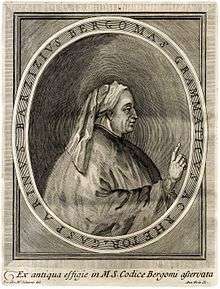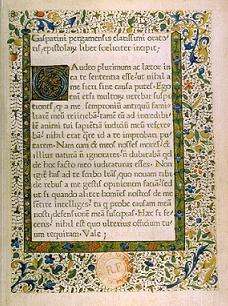Gasparinus de Bergamo
Gasparinus de Bergamo (in Italian, Gasparino (da) Barzizza; in French, Gasparin de Bergame; in Latin, Gasparinus Barzizius Bergomensis or Pergamensis) (c. 1360 – c. 1431) was an Italian grammarian and teacher noted for introducing a new style of epistolary Latin inspired by the works of Cicero.


With Pier Paolo Vergerio the Elder, he was influential in the development of humanism at Padua. As one of the first Italian Humanists, he taught rhetoric, grammar, and moral philosophy with the aim of reviving Latin literature.
Biography
Born Gasparino Di Pietrobuono in the village of Barzizza, near Bergamo, he studied grammar and rhetoric at Pavia. Remaining there to teach from 1403 to 1407, he subsequently moved to Venice to serve as private tutor to the Barbaro family.
Unable to find backing in Venice in order to establish a school there, Gasparinus then taught at Padua (1407–21), enjoying his most productive writing period, where his reputation as a teacher and scholar was established. He was appointed to lecture there on rhetoric and on authors such as Seneca, Cicero, Virgil, and Terence. He also established the elementary school, which offered a humanist curriculum. Both Vittorino da Feltre and Leon Battista Alberti owed their boyhood education to him. Antonio Beccadelli, called "Il Panormita", also studied under him.
He then taught at Ferrara, and on the invitation of Filippo Maria Visconti, opened an elementary school at Milan in 1418, to be organized along the same lines as Gasparinus' school at Padua. He taught at Milan from 1421 and also served as Visconti's court orator.
Gasparinus also served as secretary to Pope Martin V and in this capacity attended the Council of Constance. Gasparinus died at Milan around 1431.
By his marriage to Lucrezia Alliardi, Gasparinus had a son, named Guimforte (Guiniforto) Barzizza (c. 1406–63), who became a distinguished scholar and writer. Guimforte married Giovannina Malabarba.
Works
- Epistolarum liber ("Book of Letters") or Epistolae ("Letters"): his most famous work, which carries the distinction of being the first book printed in France (Paris), in 1470, with the newly introduced printing press by Johann Heynlin. This work was intended to provide an exemplar for students for the writing of artful and elegant Latin and was designed to teach prose composition.
- Tractatus de compositione (ca. 1420): a treatise on rhetoric and literary style. In this treatise, Gasparinus argued for a return to the elements of style found in the rhetoricians of antiquity.
- Orthographia: a manual of Latin orthography, his most important work.
- possibly the Sinonima Ciceronis ("Synonyms of Cicero"): a collection of synonymous terms used in the rhetorical works of Cicero, produced to aid in the expansion of students' rhetorical vocabulary in Latin.[1]
References
- The work is anonymous, but R.G.G. Mercer suggests, in The Teaching of Gasparino Barzizza: With Special Reference to his Place in Paduan Humanism (London, 1979; p. 66) that it may well be the work of Barzizza.
Sources
- Un altro codice col commento di Barzizza alle ad Lucilium (in Italian)
- Philology and linguistics (in Italian)
- The Classical Renaissance (in English)
- Miscellany of Humanistic Texts (in Italian)
- Palazzo Barzizza (in Italian)
Further reading
- Robert P. Sonkowsky, "Magister Gasparinus", The Speech Teacher, 12 (1963), 200-203.
- Robert P. Sonkowsky, "Critical Edition of the Latin Rhetorical Treatise De Compositione by Gasparino Barzizza of Bergamo", American Philosophical Society: Year Book, 1962, 629.